Why AdRoll is Your Ideal Programmatic DSP
AdRoll helps you run full-funnel, multi-channel ad campaigns. Learn how our programmatic DSP enables better ad campaigns that convert customers.
Read More
Balancing a healthy mix of targeting strategies is critical when customers are budget-conscious — particularly when a targeting strategy can improve ROI in the privacy-forward future. That ROI-boosting strategy is contextual targeting.
Retargeting and other cookie-based strategies are essential, but they don't capture the entire audience. What about the one in five consumers who opt out of cookies? Or the potential new customers you haven't engaged with yet?
Keyword contextual targeting can help these customers. By placing your ads on webpages that are topically relevant to your brand, you can reach customers without relying on third-party cookies.
Let’s show you what keyword-based contextual targeting is, why it works, and how to use it.
Contextual targeting serves ads to users on websites based on the webpage content they are actively consuming, rather than the user's browser history or personal data. This targeting tactic is used to reach new prospects and bring net new visitors to your website.
For example, a marketer selling a new suitcase can use this tactic to deliver relevant ads to people who are actively reading travel articles, knowing that they most likely may want to purchase a new suitcase for an upcoming trip.
Not all contextual targeting is equal, however. Let’s go into the specific types.
This is the broadest form of contextual targeting. An advertiser chooses from predefined, general categories (e.g., "Sports," "Technology," "Travel," "Finance," etc.) that are typically provided by their ad platform of choice. The ad platform places the ad on any website that falls within the chosen categories.
For example, an ad for a running shoe brand might be placed on a blog post categorized as "Sports & Fitness." The article could be a review of a new gym, a post about healthy eating, or a list of the best places to hike. The ad's appearance is based on the general topic of the page, not the specific keywords.
You can take this a step further with keyword contextual targeting. Our approach to keyword contextual targeting, which combines natural language processing and semantic analysis, crawls and analyzes the content of a webpage.
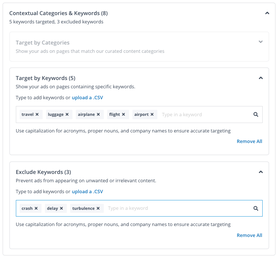
Now that we’ve established the swim lanes of contextual targeting, we can move into keyword targeting specifically to learn more about the approach.
Keyword contextual targeting works like this:
Natural language processing looks for specific keywords in the page's HTML.
Semantic analysis understands the overall meaning and context of the page. This is what allows our platform to differentiate between "Apple" the technology company and "apple" the fruit, ensuring your technology ads don't end up on a recipe blog.
With both NLP and semantic analysis combined, your ads are placed on the most relevant pages, reaching your target audience while they’re consuming content related to your brand.
Contextual targeting is more important than ever. Its growth in popularity is in part because it’s an effective way to reach a non-cookied audience. Here’s why more advertisers are using it.
Consumers are choosing to opt out of cookies, whether Chrome does or not. In fact, fewer than one in five consumers accept cookies when given the choice. This means marketers must have a strategy in place to reach this segment of the audience.
Contextual targeting is a cookie-free solution to ensure your campaigns maintain their reach and are still relevant to your audience.
Contextual targeting lets you control the webpages your ads appear on, which is essential for brand safety.
Positive keyword targeting ensures your ads only appear on webpages with the keywords you have provided. This means you are only showing ads to people who are most likely to be interested in your offering.
Negative keyword targeting ensures your ads don’t appear on webpages that have specific keywords you have provided. This protects your ads from showing alongside content that does not align or could hurt your brand story.
You can precisely target content that supports your brand, ensuring your budget is spent on pages where your potential customers are most engaged. At the same time, you can protect your brand by excluding sensitive or irrelevant topics, preventing your ads from appearing in inappropriate contexts.
Contextual targeting can also be used in retargeting campaigns. It can prevent your ads from appearing next to content that would damage your brand or can be used to specify the websites you want your ads to appear on.
This is particularly relevant for retargeting campaigns to better control your ad placements. You can provide positive keywords that support your brand messaging or add negative keywords associating your messaging with themes or topics that don’t resonate with your audience.
Most DSPs help you navigate contextual targeting through their platform. We’ll use the platform we know best as an example walkthrough: AdRoll.
You can set up a contextual targeting campaign much the same way you’d start any campaign — it’s the features of contextual targeting that you need to know how to use.
Positive keywords are the keywords you want to target. For example, if you sell athletic shoes, you could target keywords like “exercise," "gym," and "running." Our platform will then show your ads on pages that contain this content.
You can target up to 100 positive keywords, meaning you can go for depth and breadth.
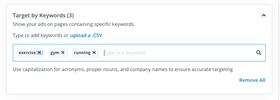
Negative keywords are the keywords you want to exclude for brand safety. A perfect use case is for airlines. They might use negative keywords such as "plane crash" or "flight disaster" to ensure their ads never appear on news articles covering these topics.
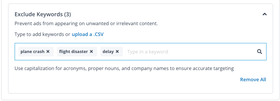
If you want to target a broader audience, you can choose from predefined contextual categories. AdRoll’s NLP technology automatically categorizes a vast number of web pages into buckets like "automotive," "financial services," or "dating," allowing you to quickly and effectively target a large, relevant audience with just a few clicks. We have over 50 content categories to choose from.
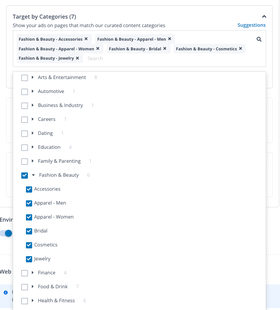
Once your contextual targeting campaign is live, AdRoll provides detailed reporting on the performance of each keyword and category. You can see key metrics like impressions, CTR, clicks, and CPC to understand what's working best and optimize your strategy:
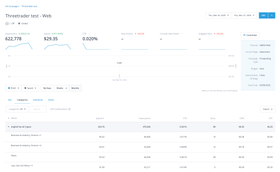
Naturally, each campaign and brand is unique. Some succeed with category targeting, other need to include negative keywords to protect their brand. Here's how you could set up a campaign AdRoll's contextual targeting that will match your use case:
If you’re launching a campaign that relies solely on contextual targeting, decide on which contextual targeting tactics are best for your campaign during setup. Each method offers something slightly different, and it takes experimentation to find the right tactic for a campaign.
Consider targeting categories as well if your campaign falls into one of our 50 predefined contextual targeting categories — with everything from Sports, Automotive, Travel, Finance, and more.
With category targeting, it’s easy to identify categories relevant to your offering and let AdRoll find the right placements. AdRoll’s NLP and semantic analysis is constantly evaluating webpages to sort them into these categories. By using category contextual targeting, you’re able to showcase ads beside topics relevant to your product.
On the other hand, consider positive keyword targeting if you know specific words or phrases that resonate most with your target audience. This helps AdRoll place ads on webpages where those keywords are displayed allowing more precise targeting.
If certain words or phrases don’t align with your brand messaging, that’s when you use negative keyword targeting. AdRoll won’t display your ads on pages where those keywords appear, giving you greater control over brand safety.
Be sure to test all of these contextual targeting tactics to find the most relevant. You may be surprised which keywords, categories, and combinations work after experimentation.
You can also layer contextual targeting into retargeting campaigns.
Once you’ve identified your target list, to increase control over where your ads appear, you can layer on contextual positive and negative keywords.
From there, the process for contextual targeting is the same. If there are certain words or phrases that resonate with your offering, include them in the retargeting campaign. To avoid terms or phrases, use negative keywords.
Contextual targeting is a privacy-friendly way to expand your reach — it’s effective, smart, and tailored to your brand. To recap what we’ve learned:
Keyword contextual targeting is a privacy-friendly advertising strategy that places ads on webpages based on the page's content, not on a user's browsing history or personal data. This helps you reach new audiences who have opted out of third-party cookies.
The most effective approach combines keyword and category targeting. By using a broad category for reach and specific keywords for relevance, you can ensure your ads appear on relevant pages without being too restrictive.
To get the most out of this strategy, you can use positive keywords to target relevant content and negative keywords to prevent your ads from appearing on irrelevant or sensitive pages.
AdRoll's powerful tools empower you to take full control of your ad placements, ensuring every impression counts.
Want to learn more about contextual targeting? Check out AdRoll.
Last updated on September 11th, 2025.